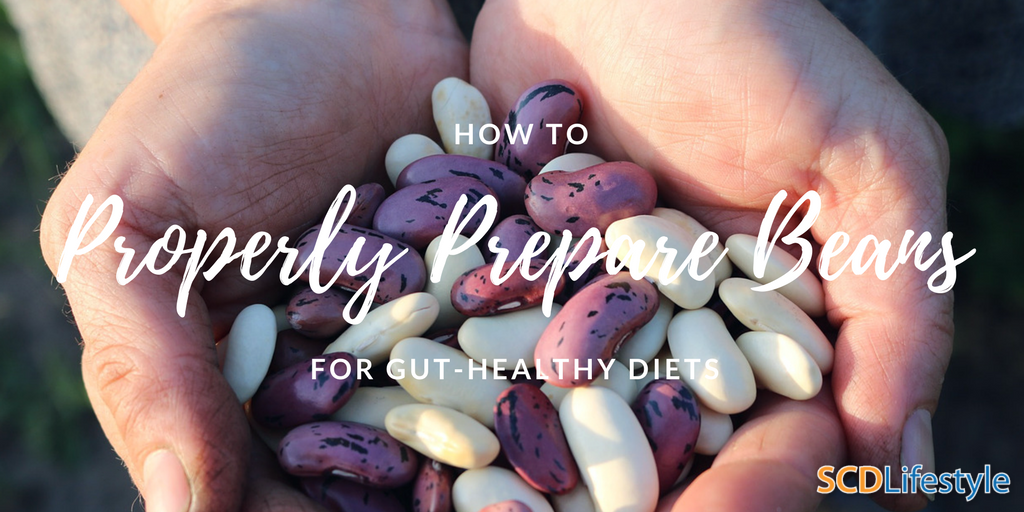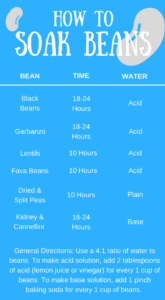How To Properly Prepare Beans (So They’re Gut-Healthy)

If you’re following an ancestral or gut-healthy diet like SCD, AIP, GAPS, paleo, or a leaky gut diet, beans are one of the most confusing foods you’ll hear discussed.
On the one hand, you probably grew up believing beans to be a “healthy food.” They’re versatile, cheap, tasty, and filling… there’s a good reason they are a staple in diets around the world.
But on the other hand, if you’re interested in gut health, you may have heard some bad news about beans…
Like that beans contain anti-nutrients. Or that they damage your gut. That they are actually really bad for you.
So which is true? Are beans good or bad?
The truth is that (like just about any food) beans and legumes aren’t strictly good or bad.
Depending on the individual, beans may or may not be a good food for you right now.
But one thing is certain: to be a healthy food for anyone, beans must be properly prepared.
When prepared properly, beans are a nutrient-dense food that can nourish your body. In this article, I’ll briefly cover the bean controversy plus share how to safely prepare beans at home.
Why Do Beans Have a Bad Rap?
Beans, like all plant foods, contain anti-nutrients.
Anti-nutrients are mother nature’s way of protecting plants from being eaten by other organisms.
Some anti-nutrients you’ve probably heard of:
- Lectins
- Phytates
- Tannins
- Oxalates
- Gluten
- Saponins
- And many more
(A side note – you’ll also hear many of these referred to as acids – i.e. oxalates as oxalic acid, or phytates as phytic acid – for our understanding, it’s just a different way of saying the same thing.)
Beans contain high levels of both lectins and phytates, which is why some gut-healing diets exclude beans entirely.
Are Lectins Making You Sick?
Lectins are a type of anti-nutrient found in many plant foods – everything from grains and beans to squash and nightshades.
Uncooked beans contain high levels of lectins – and when not cooked thoroughly, can make people sick.
Recently, diets that limit or avoid foods high in lectins have become popular.
And while it’s true that over consuming lectins can cause symptoms in sensitive people (especially those with conditions like leaky gut or autoimmunity), most lectins are removed by cooking.
In fact, pressure cooking beans for as little as 7.5 minutes almost entirely deactivates the lectin they contain.
So, as our friend Chris Kresser puts it,
Is Phytic Acid Stealing Your Nutrients?
Phytate contains a form of phosphorus that is not bioavailable to humans and other primates. This means we aren’t able to absorb and break down the phosphorus contained in the phytate. (Animals like cows who have multiple stomachs are better able to digest the phytates in beans and grains.)
The unabsorbed phosphorous then binds to calcium, zinc, magnesium, copper, and iron in the intestinal tract – meaning that not only do we not digest the nutrients present in food high in phytates – you also miss out on the nutrients in other foods because the phytates “steal” them.
Fear over the consequences of phytates “stealing” nutrients led many people to completely remove beans from their diet. While we respect each person’s right to customize their diet to their own needs, you certainly don’t have to eliminate beans to be healthy or safeguard your nutrients.
But by soaking beans before cooking, you can drastically reduce the amount of phytates in beans and make them much safer to consume, even in large quantities. Plus, it’s easy, cheap, and requires no special skills.
Proper Preparation Makes Beans Gut-Healthy
Let’s briefly go back to cows for a minute.
Animals that graze on grains for the majority of their food have multiple stomachs that help them break down anti-nutrients like phytates found in plant foods.
Humans have just one stomach.
Luckily, we have something else that helps us break down our food and make it easier to digest: kitchens!
I’m not kidding! By preparing our foods properly, we can make them less harmful, more beneficial, and much easier to digest.
Beans are a prime example of this. By soaking beans before cooking them, we can greatly reduce the levels of phytic acid present in the finished beans.
In a sense, soaking and cooking (especially pressure cooking) act like 2 extra stomachs for us!
Soaking beans before cooking them also makes them less likely to cause digestive disturbances like bloating and gas.
How to Soak Beans
Soaking beans is very straightforward.
There are 3 elements to consider when soaking beans:
- Type of bean
- Length of time
- And water solution
If all else fails, soaking any dried beans in plain water overnight is better than not soaking at all – but you can customize the soak to reap the most benefits.
Here’s how I soak my beans:
- Using a 4:1 ratio of beans to water, I soak them for 10-24 hours in warm water with either an acid or a base added – or nothing added at all (it all depends on the type of bean)
- For acids, I use either lemon juice or vinegar, and add 2 tablespoons for every 1 cup of beans
- For my base, I add 1 pinch of baking soda per 1 cup of beans
- After soaking, I drain and rinse the beans and then cook them according to my recipe
This chart can help you figure out what to add to your water, based on the bean you’re using:
For example, if I was soaking 2 cups of dried black beans I would combine the 2 cups dried beans, 8 cups warm water, and 4 tablespoons (or 1/4 cup) lemon juice or vinegar. I’d allow them to soak for 18 – 24 hours. If I was planning to have beans as part of my dinner Tuesday night, this might mean setting them out to soak as I was preparing dinner Monday night.
Beans Are Back on the Menu
If you’ve been excluding beans from your diet, I hope soaking and properly preparing them allows you to reintroduce them.
Remember that there isn’t a “one-size-fits-all” diet and the best way to know if beans work for you is to test them out!
If you feel overwhelmed and confused by figuring out what to eat, what foods to avoid, or how to test out reintroducing foods, I hope you’ll consider attending a free webinar on our Solving Leaky Gut course.
In Solving Leaky Gut, you’ll learn how to follow an elimination and reintroduction diet to heal your gut and find the perfect diet – customized to your unique needs.
Does this sound like something you need help with? Sign up for a free webinar here (we’ll email you a recording, too!).
In health,
Jordan
P.S. – Do you have a favorite bean recipe? Please share it with us in the comments section!
Did You Like this Article?
Subscribe to our newsletter to receive email notifications, some ways to find relief, and next steps.

